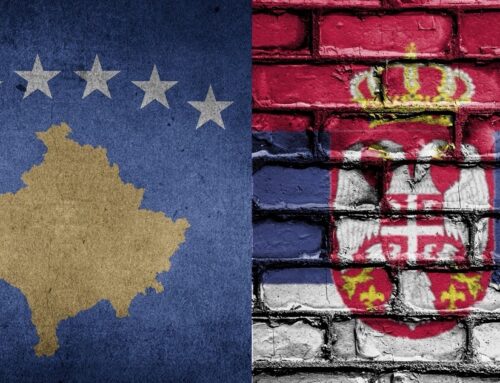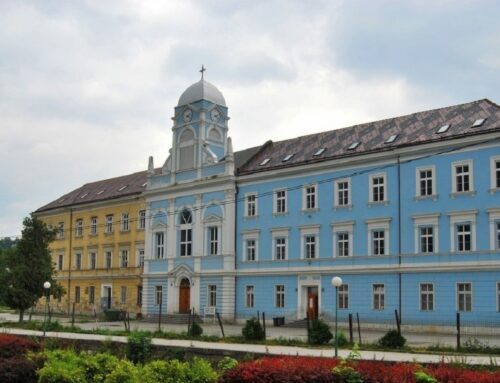- The Origin of the Balkan Jews
The history of the Balkan Jews lasts more than 500 years. The deportation of the Balkan Jews occurred in 1941 and lasted until 1945. Initially, the Jews were exiled in 1492 from Spain (a period known as the Spanish Inquisition). Later on, the Sultan of the Ottoman Empire, Bayezid II, accepted and welcomed them as dhimmis (foreigners who lived in Muslim lands or territories). The Jews for the Ottomans were the “Ahl al-kitab”(the “People of the Book”). Christians and Muslims were holding the same religious status. The People of the Book are the members of the three monotheistic religions (Christianity, Islam and Judaism) who believe in the Bible, the Quran and the Torah. The Ottomans implemented the policy of accommodation (istimalet) regarding foreigners (mainly for Jews and Christians) in order to preserve the cosmopolitan character of the empire. The names of some Balkan cities where the Jewish population was living for centuries were: Sarajevo (Bosnia and Herzegovina), Monastir (Bitola – Macedonia), Belgrade (Serbia), Split and Dubrovnik (Croatia). Many Jewish people lived in Skopje (Macedonia) and Zagreb (Croatia) as well. However, it is crucial to mention that the Jewish community lived in the Balkan region since the 1st century CE (the era of the Roman Empire).
- Prominent Jewish Figures
Some prominent personalities among the Balkan Jews were Estreja Ovadija – Mara (Haim Estreya Ovadya) from Bitola (Macedonia), Slavko Goldstein from Karlovac (Croatia), Seka Sablić from Serbia, Danilo Kiš from Hungary, Branko Lustig from Hungary, Breda Kalef from Serbia and Jakob Finci from Bosnia and Herzegovina.
Elvira Kohn was a Jewish photographer from Zagreb, Croatia. Breda Kalef is an opera singer living in Belgrade. Estreya Ovadya was a member of the Yugoslav Partisans Unit (National Liberation Army) against the Germans (1941 – the year of the German occupation of Yugoslavia). Estreya Ovadya died relatively young, at the age of 22. Slavko Goldstein was a famous Croatian politician and a historian. Seka Sablić is a Serbian actress, while Danilo Kiš was a prominent Hungarian novelist. Branko Lustig was a Croatian film producer, while Jakob Finci is the president of the Jewish Community Center of Bosnia and Herzegovina.
- The Dark Side of History: the deportation of the Balkan Jews
The Balkan Jewish history was marked by a happy beginning and a sad end. The happy beginning occurred in 1492 when the Ottoman Empire accepted and welcomed thousands of Jewish refugees coming from Spain. However, the dark end started with the fatal emergence of the Holocaust.
During the Holocaust, Macedonia was one of the countries that lost its entire Jewish community. The Jews from Bitola, Skopje and Štip were gathered in the Tobacco Monopoly in Skopje before being transported into the trains and deported to the Treblinka concentration camp.
The worst Balkan concentration camp was Jasenovac (1941-1945) located in Croatia. In this camp were detained not only Jews but also Serbians, Croats, Roma people and Bosnians. Unfortunately, more than 100 000 people perished in this camp. The Jasenovac camp was liberated by the Yugoslav Partisan Unit.
Who should be blamed? Which evidence should be claimed? Will there be an international trial in the future for the atrocities committed in the camp Jasenovac or maybe an adhoc jurisdiction? There is a tradition in the Balkan countries trials to start 20 or 30 years after the atrocities were committed, which undeniably threatens the well-being of the legal security and the preservation of the public order.
Among the Jewish people, who joined the Yugoslav Partisans Unit was also Samoil Mizrahi. He is one of the few Macedonian Jewish survivors. Rashela Mizrahi, the current member of the Macedonian political party VMRO-DPMNE and deputy of parliament, is the granddaughter of Samoil Mizrahi. Before the emergence of World War II, almost 8000 Jewish people lived in different regions of Macedonia, mainly Skopje, Bitola and Štip. More than 3000 people were deported from Bitola, around 700 from Štip, and the rest from the suburbs of Skopje.
The author Michalopoulos Dimitris in his article“The Salonica Issue and the Balkan Wars” published in the Journal of Balkan Research Institute of Trakya University (Turkey) said that Salonica (Thessaloniki) was a distinguished Jewish city until the emergence of World War II: “Salonica was a Jewish and not a Greek city early in the twentieth century”[1].
- The Jewish culture of Bosnia and Herzegovina
The majority of the Jews of Bosnia were of Sephardic origin. There were also Ashkenazi Jews, especially during the Austro-Hungarian occupation of Bosnia. More than 20 000 Jews lived in Bosnia, mainly in the capital Sarajevo. However, nowadays less than 300 Jews remain in Bosnia. All others were persecuted during World War II, and were deported to Auschwitz. One of the most famous Bosnian Jewish documents is the Sarajevo Haggadah dating back to the 14th century. This historical document illustrates the narration of the biblical event known as the Exodus (the liberation of the Jewish people from the Egyptian slavery that literally lasted for centuries). This holiday in the Jewish tradition is known as the Passover or Pesach. The Jewish storytelling tradition known as a mitzvah (commandment) depicts the essence of the Haggadah. Each Jewish parent needs to tell his/her child the story of the Haggadah.
- The Zagreb Synagogue: a forgotten historical monument
The Zagreb Synagogue was originally built in 1867 portraying the essence of Moorish architecture. Moorish architecture is a mixture between Western art and some elements of Islamic art. The synagogue, unfortunately, was ruined multiple times. Michele Levy in her article “Brief History of the Balkan Jews and the Story of the Synagogue of Zagreb”, published on the website of the Jewish Book Council, stated that the destiny of the Balkan Jews was often coined by the decisions taken by the Balkan local councils: “But the fate of the Balkan Jews, as with their Western counterparts, depended on the disposition of their local governments”[2]. The Zagreb Synagogue is known also as the Moorish Revival Synagogue and its architecture was very similar to the Leopoldstäter Tempel in Vienna (Austria). The Ashkenazi Synagogue of Sarajevo embraces also the architectural style of Moorish art.
- The defensive elements of transitional justice: truth commissions
Truth commissions are established after genocides are committed. The main role of the truth commissions is to conduct the process of the discovery of the truth based on scientific results or proofs. Regarding the Holocaust, the Nuremberg trials were organized and the war perpetrators were held accountable for committing the worst crimes in history mainly to Jews, but also for persecuting the Gypsies and people of Slavic origin. Three years later, after the Genocide of Srebrenica, more precisely, in 1999, the International Criminal Tribunal for the former Yugoslavia was established. It is certain that the world didn’t learn yet the lessons from the Holocaust, that’s why numerous wars still occur nowadays.
- The image of the Nuremberg trials – the presence of a fictive justice?
The Nuremberg trials persecuted the Nazi criminals that breached the primary laws of the war and committed the worst crimes against humanity. Thirteen trials were conducted between 1945 and 1946. There were 177 defendants in total. Only 24 of them were sentenced to death (capital punishment). Why the image of the Nuremberg trials may depict the dark side of the fictive justice of the 20th century? Well, the answer is complicated. Firstly, it is important to mention that more than 6 000 000 Jewish people perished in the concentration camps of Treblinka, Auschwitz-Birkenau, Belzec and Flossenbürg . It is highly controversial that only 24 defendants were found guilty of the assassination of 6 million people. It is theoretically impossible. There must have been many more accomplices. Why the justice did select only a few ones?! Who holds the answer? The judges, the politicians, the doctors? This is why the image of the Nuremberg trials illustrates the fictive infrastructure or institutionalization of legal penalties. It is certainly clear that legal justice is famous for not individualizing the crimes, but for collectivizing them. This means that the obscurity of legal trials is perfectly hidden. Moreover, legal trials always try to reconstruct the reality of the crimes, what happened, when and how. This is how judges measure the gravity of crimes.
- Conclusion
To conclude, the Holocaust, the Genocide of Srebrenica, the Genocide of Rwanda are the world’s darkest and worst atrocities. The political leaders should wake up, being dormant won’t serve them, because humans’ lives are in question. The worst outcome of the war is the countless number of victims. Apparently, yet certainly, is very easy to sit in the political chair of governance (the presidential chair or the one of the Prime Minister), but to serve the people that elected you is portrayed to be an impossible mission. This is called an abuse of office, and in legal terms, abuse of office requires a sanction or in other words ‘impeachment’. Similarly, history teaches us lessons, but the elected political leaders obliterate these lessons, or close their eyes in front of the real truth or the problems the people live with. If we observe the situation more closely, the unique legal objective is to entail responsibilities. But for who? Generally, this rule is abided by the civilians, politicians generally do not follow this rule, rarely, especially in the countries where dictatorship rules and the presidents extend each time their mandates. The longevity of the mandates lasts for a few decades, which in essence reminds us of the communist way or monarchical model of governance where the charisma of the ruler is portraying its omnipotency and reputation. This conception is against the values of democracy. Generally, the mandate of an elected leader should last for 5 years at maximum and no more. Only by implementing properly the values of democracy, and eradicating the status of perennial leaders governing for many decades, we can perhaps live in a harmonious society with incredible cultural diversity. Always the decision of the popular vote should be adopted during elections. In other words, the electoral procedure of Universal Direct Suffrage (UDS) should be the primary contributor to a peaceful society. In the aftermath of war such as the one in Bosnia and Rwanda, only transitional justice can exist, but never again, a democracy, because of ethnic tensions and social disruptions. What is the image of democracy in a transitional society? Well, it is a very complicated one, for instance in the case of Bosnia, the political regime is very unique: tripartite separation of powers, three presidents, three Prime Ministers. Moreover, regarding Jewish history, it is very true that even after the Holocaust, there is an increased rate of antisemitism. Muslims in the world face the threat of Islamophobia coined by the West. The world is in a state of chaos, and the political leaders do not notice even that. What is the future of democracy? We don’t know yet. The failure of the legal system doesn’t give us the possibility to predict the future of democracy.
Bibliography:
Books:
- Alboher, Shlomo. (2010). The Jews of Monastir Macedonia. The Life and Times of the Departed Jewish Community of Bitola. Translated from Hebrew by Eliezer E.Cohen. pp.1-314.
- The Balkan Wars and the Jews. The American Jewish Year Book 2008, Vol.15, the Jewish Publication Society 1888 – 1913 (October 2, 1913, to September 20, 1914/5674), pp.188-206
- MacDonald, David Bruce. (2003). Balkan Holocausts? Serbian and Croatian victim centred propaganda and the war in Yugoslavia. New Approaches to Conflict Analysis. Manchester University Press. pp.1-266
Articles:
- Levy, Michele. (2020, August 3). A Brief History of the Balkan Jews and the Story of the Synagogue of Zagreb.
- Stojanovic, Milica. (2021, April 15). Anti-Semitism Used as a Tool in Balkan Disputes: Report. Balkan Transitional Justice: https://balkaninsight.com/2021/04/15/anti-semitism-used-as-tool-in-balkan-disputes-report/
- Michalopoulos, Dimitris. (2012). The Salonica Issue and the Balkan Wars. Journal of Balkan Research Institute. Republic of Turkey, Trakya University. pp.57-66.
- The Balkan Wars and the Jews. The American Jewish Year Book 2008, Vol.15, the Jewish Publication Society 1888 – 1913 (October 2, 1913, to September 20, 1914/5674), pp.188-206
[1] Michalopoulos, Dimitris. (2012). The Salonica Issue and the Balkan Wars. Journal of Balkan Research Institute. Republic of Turkey, Trakya University. p.57
[2] extract of the article “A Brief History of the Balkan Jews and the Story of the Synagogue of Zagreb” written by the scholar Levy, Michele. (2020, August 3) on the website of the Jewish Book Council: https://www.jewishbookcouncil.org/pb-daily/a-brief-history-of-balkan-jews-and-the-story-of-the-synagogue-of-zagreb





